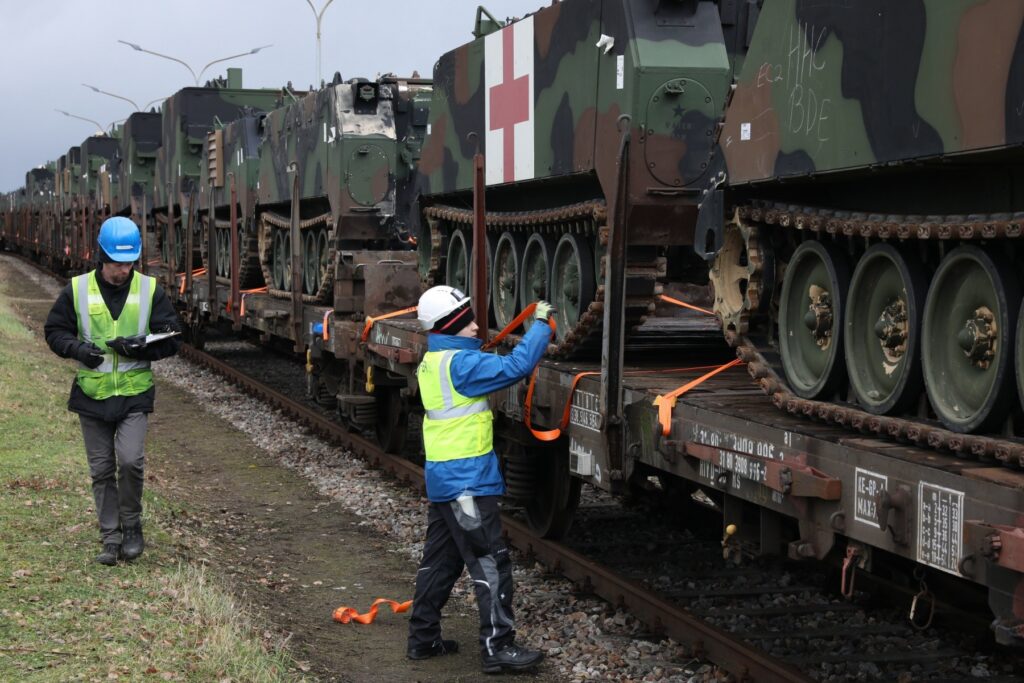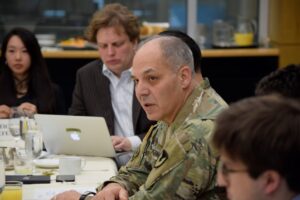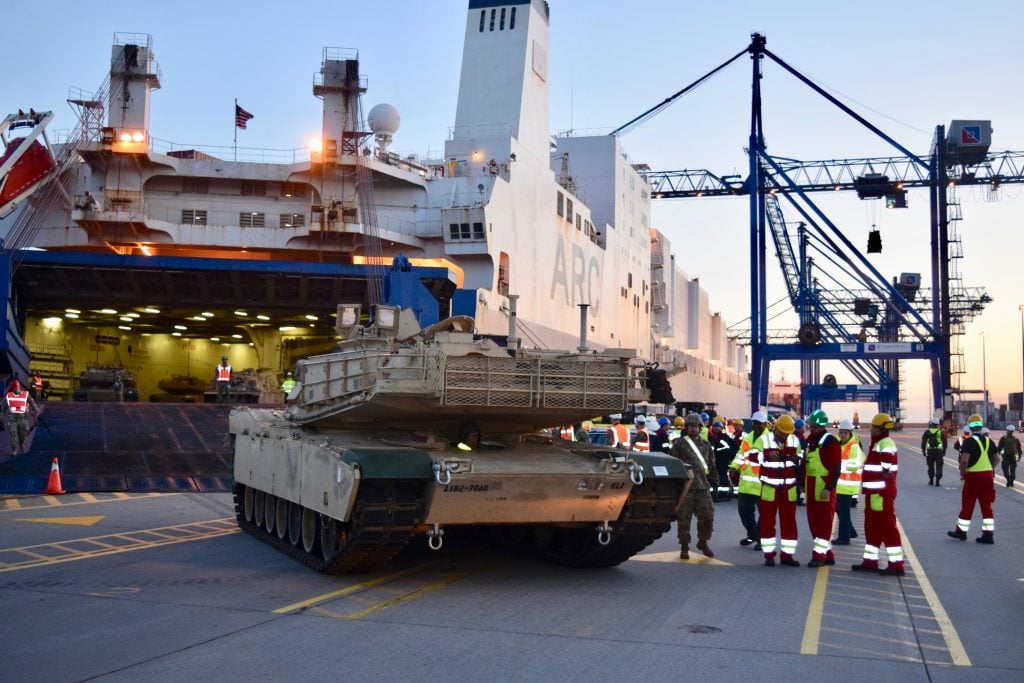
On Jan. 28, armored vehicles from the Army Prepositioned Stocks in Germany were loaded onto railcars for the Defender 2020 wargames.
WASHINGTON: Across Europe, supply officers are already breaking open Army Prepositioned Stocks — everything from M1 tanks to medical supplies — for Defender 2020, the largest NATO wargame in two decades. Back in the US, meanwhile, the four-star chief of Army Materiel Command is building an additional APS set for Europe and preparing to build more for Asia to aid in future great power combat.

Gen. Gus Perna speaks to reporters this morning (courtesy GW Project for Media & National Security)
“As of right now, I am actually building an additional set,” Gen. Gus Perna told reporters at the Defense Writers’ Group this morning. Whether it will go to one of the existing APS sites in Europe or a new one, he said, is up to the chief of the joint European Command, Air Force Gen. Tod Wolters, and US Army Europe chief, Lt. Gen. Christopher Cavoli. “In fact,” Perna said, “I head over to visit with Gen. Cavoli in a couple of weeks.”
Meanwhile, Perna said, “we’re already working on ways to expand APS out in the Pacific.” The new commander of US Army Pacific, Gen. Paul LaCamera, and the joint Indo-Pacific Command, chief Adm. Philip Davidson, are looking at adding Army Prepositioned Stocks in Asia beyond those already supporting US forces in South Korea. Once their survey is done, Perna said, “they’ll come back and brief courses of action to the Secretary and Chief.”
As the US struggles to refocus from the Middle East to China, it has to prepare to fight a high-tech great power at the end of a 6,000-mile supply line, something it hasn’t had to do since World War II. “Not since then has it really been executed at that scale,” Perna said. “APS is a way to get ahead of that.”
The reason for APS is that armored vehicles, artillery shells, and other essentials are too heavy to deliver in bulk by aircraft, but sending them by ship – which can take weeks or months – is often too slow in a crisis. Instead, you can just fly in the troops and have them equip themselves from stockpiles already prepositioned (hence the name) in a potential war zone.
Those stockpiles have to be carefully maintained, updated with new technology as necessary, and used in frequent exercises so troops learn how to equip themselves ASAP in a crisis. “It’s not just [put it in] a warehouse and high-five ourselves,” Perna said. “It’s get it there, make sure it’s ready for combat, and then exercise it and demonstrate that we can maneuver it around the Pacific.”
In Asia, Europe, and the Middle East – where 82nd Airborne troops drew on prepositioned stocks after urgently deploying to shore up defenses against Iran – APS is not just a practical precaution but a strategic deterrent, Perna argued: “We want to show our enemies [that] we’re not going to sit around and wait for you to start, we’re going to be ready.”

A US Army M1 Abrams heavy tank unloads from a transport ship in Poland.
The stockpiles overseas are just one link in a much larger chain required for rapid deployment to a crisis, much of it Perna’s responsibility. In fact, while his Army Materiel Command has given up its R&D labs to the newly created Futures Command, ceding its role in developing new equipment, it has taken on a larger role in sustaining the current force. AMC now incorporates previously independent organizations for medical equipment & supplies, finances, and installation management.
“We didn’t wake up one day and say they needed to move,” Perna said. “These were well-thought-out courses of action to take capability and put it under a [single] commander… able to execute Multi-Domain Operations.” MDO is the rapidly evolving inter-service concept for future long-range conflicts over land, sea, air, space, and cyberspace.
In particular, Perna’s new responsibility to improve aging infrastructure at Army bases, railheads, and port facilities means he’s basically building the US launchpad for future operations overseas. As the Army’s lead for what MDO calls the strategic support area, Perna must also protect that infrastructure from cyber attack, physical sabotage, and disinformation – all of which an adversary might employ long before the outbreak of open war.
“Cyber is a clearly a weapon that’s going to be used against us,” among others, Perna said. “They’re looking for our vulnerabilities… trying to keep us from even leaving the United States.”
Defender 2020 is the biggest deployment wargame yet. But the Army has been working hard since 2016 to relearn rapid-deployment skills that atrophied over a generation of routinized, predictable (albeit grueling) rotations to Afghanistan and Iraq. “When was the last time we deployed to war?” Perna said. “2003 was the last time we emptied barracks and motor pools, got on trains and planes and ships, and showed up” in a new war zone.
More troubling still, in 2003, the Iraqis had virtually zero ability to sabotage US infrastructure, shoot down transport planes, or sink cargo ships: They had to sit and wait for America to launch the war at the time of its own choosing. A Russia or China won’t be so limited.
“We may or may not have the freedom of maneuver,” Perna warned, “the luxury that we had when we went into Iraq in 2003 and Afghanistan in 2001.”






















